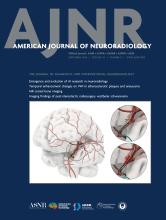Index by author
Dovjak, Gregor O.
- PediatricsOpen AccessSynthetic MRI and MR Fingerprinting–Derived Relaxometry of Antenatal Human Brainstem Myelination: A Postmortem-Based Quantitative Imaging StudyVictor U. Schmidbauer, Intesar-Victoria Malla Houech, Jakob Malik, Martin L. Watzenboeck, Rebecca Mittermaier, Patric Kienast, Christina Haberl, Ivana Pogledic, Christian Mitter, Gregor O. Dovjak, Astrid Krauskopf, Florian Prayer, Marlene Stuempflen, Tim Dorittke, Nikolai A. Gantner, Julia Binder, Dieter Bettelheim, Herbert Kiss, Christine Haberler, Ellen Gelpi, Daniela Prayer and Gregor KasprianAmerican Journal of Neuroradiology September 2024, 45 (9) 1327-1334; DOI: https://doi.org/10.3174/ajnr.A8337
Du, Yi-fan
- Artificial IntelligenceYou have accessIntegrating Clinical Data and Radiomics and Deep Learning Features for End-to-End Delayed Cerebral Ischemia Prediction on Noncontrast CTQi-qi Ban, Hao-tian Zhang, Wei Wang, Yi-fan Du, Yi Zhao, Ai-jun Peng and Hang QuAmerican Journal of Neuroradiology September 2024, 45 (9) 1260-1268; DOI: https://doi.org/10.3174/ajnr.A8301
Eckhard, Andreas H.
- EDITOR'S CHOICEHead and Neck ImagingYou have accessRetrolabyrinthine Bone Thickness as a Radiologic Marker for the Hypoplastic Endotype in Menière DiseaseAmy F. Juliano, Kuei-You Lin, Nitesh Shekhrajka, Donghoon Shin, Steven D. Rauch and Andreas H. EckhardAmerican Journal of Neuroradiology September 2024, 45 (9) 1363-1369; DOI: https://doi.org/10.3174/ajnr.A8339
There are 2 major endotypes of Menière disease: one with a hypoplastic, underdeveloped endolymphatic sac and one with a normally developed sac that degenerates over time. This study explored the link between angular trajectory of the vestibular aqueduct and the thickness of the retrolabyrinthine bone to provide differentiation between MD endotypes using CT and MRI. The average retrolabyrinthine bone thickness was statistically significantly different between endotypes with retrolabyrinthine bone thickness >=1.2 mm, effectively ruling out hypoplastic Menière disease.
Eldeniz, Cihat
- EDITOR'S CHOICEArtificial IntelligenceYou have accessMR Cranial Bone Imaging: Evaluation of Both Motion-Corrected and Automated Deep Learning Pseudo-CT Estimated MR ImagesAndrew D. Linkugel, Tongyao Wang, Parna Eshraghi Boroojeni, Cihat Eldeniz, Yasheng Chen, Gary B. Skolnick, Paul K. Commean, Corinne M. Merrill, Jennifer M. Strahle, Manu S. Goyal, Hongyu An and Kamlesh B. PatelAmerican Journal of Neuroradiology September 2024, 45 (9) 1284-1290; DOI: https://doi.org/10.3174/ajnr.A8335
In this study, the authors developed automated motion correction and used deep learning to generate pseudo-CT cranial images from MR images. Compared with CT, pseudo-CT had 100% specificity and 100% sensitivity for suture closure and 100% specificity and 90% sensitivity for skull fractures.
Elfil, Mohamed
- NeurointerventionYou have accessEndovascular Thrombectomy for Carotid Pseudo-Occlusion in the Setting of Acute Ischemic Stroke: A Comparative Systematic Review and Meta-analysisMichelle A. Toruno, Tristan Meier, Mohamed Elfil, Karthi Varshika, Jonathan Cortese, Sherief Ghozy, Ramanathan Kadirvel and David F. KallmesAmerican Journal of Neuroradiology September 2024, 45 (9) 1241-1245; DOI: https://doi.org/10.3174/ajnr.A8268
- EDITOR'S CHOICENeurointerventionYou have accessRisk of Hemorrhagic Transformation after Mechanical Thrombectomy without versus with IV Thrombolysis for Acute Ischemic Stroke: A Systematic Review and Meta-analysis of Randomized Clinical TrialsSeyed Behnam Jazayeri, Sherief Ghozy, Lina Hemmeda, Cem Bilgin, Mohamed Elfil, Ramanathan Kadirvel and David F. KallmesAmerican Journal of Neuroradiology September 2024, 45 (9) 1246-1252; DOI: https://doi.org/10.3174/ajnr.A8307
This systematic review and meta-analysis evaluated the risk of intracerebral hemorrhage, and its subtypes associated with mechanical thrombectomy with or without IV thrombolysis for the treatment of acute ischemic stroke due to large-vessel occlusion. The analysis showed that the overall risk of symptomatic intracerebral hemorrhage was comparable between mechanical thrombectomy with IV thrombolysis and mechanical thrombectomy alone.
Ertl-wagner, Birgit B.
- Artificial IntelligenceYou have accessAssessing the Emergence and Evolution of Artificial Intelligence and Machine Learning Research in NeuroradiologyAlexandre Boutet, Samuel S. Haile, Andrew Z. Yang, Hyo Jin Son, Mikail Malik, Vivek Pai, Mehran Nasralla, Jurgen Germann, Artur Vetkas, Farzad Khalvati and Birgit B. Ertl-WagnerAmerican Journal of Neuroradiology September 2024, 45 (9) 1269-1275; DOI: https://doi.org/10.3174/ajnr.A8252
Essien, Michael
- Brain Tumor ImagingYou have accessInterrater Agreement of BT-RADS for Evaluation of Follow-up MRI in Patients with Treated Primary Brain TumorMichael Essien, Maxwell E. Cooper, Ashwani Gore, Taejin L. Min, Benjamin B. Risk, Gelareh Sadigh, Ranliang Hu, Michael J. Hoch and Brent D. WeinbergAmerican Journal of Neuroradiology September 2024, 45 (9) 1308-1315; DOI: https://doi.org/10.3174/ajnr.A8322
Fan, Xiaoxue
- Head and Neck ImagingYou have accessComparing the Double-Echo Steady-State with Water Excitation and Constructive Interference in Steady-State Sequence Techniques for Identifying Extracranial Facial Nerve and Tumor Positions in Patients with Parotid TumorsXiaoxue Fan, Changwei Ding, Guyue Zhao and Yang HouAmerican Journal of Neuroradiology September 2024, 45 (9) 1355-1362; DOI: https://doi.org/10.3174/ajnr.A8309
Feyissa, Anteneh M.
- FELLOWS' JOURNAL CLUBUltra-High-Field MRI/Imaging of Epilepsy/Demyelinating Diseases/Inflammation/InfectionYou have accessRadiologic Classification of Hippocampal Sclerosis in EpilepsyErik H. Middlebrooks, Vivek Gupta, Amit K. Agarwal, Brin E. Freund, Steven A. Messina, William O. Tatum, David S. Sabsevitz, Anteneh M. Feyissa, Seyed M. Mirsattari, Fernando N. Galan, Alfredo Quinones-Hinojosa, Sanjeet S. Grewal and John V. MurrayAmerican Journal of Neuroradiology September 2024, 45 (9) 1185-1193; DOI: https://doi.org/10.3174/ajnr.A8214
This review explores how the International League Against Epilepsy (ILAE) subtypes of hippocampal sclerosis correlate with MRI findings. Hippocampal anatomy is reviewed in detail. The pathophysiology of hippocampal sclerosis is discussed. A radiologic classification scheme is proposed that aligns with the ILAE pathology classification, aiming to improve clinical communication and decision-making.
Filippi, Christopher G.
- Artificial IntelligenceYou have accessAssessing the Performance of Artificial Intelligence Models: Insights from the American Society of Functional Neuroradiology Artificial Intelligence CompetitionBin Jiang, Burak B. Ozkara, Guangming Zhu, Derek Boothroyd, Jason W. Allen, Daniel P. Barboriak, Peter Chang, Cynthia Chan, Ruchir Chaudhari, Hui Chen, Anjeza Chukus, Victoria Ding, David Douglas, Christopher G. Filippi, Adam E. Flanders, Ryan Godwin, Syed Hashmi, Christopher Hess, Kevin Hsu, Yvonne W. Lui, Joseph A. Maldjian, Patrik Michel, Sahil S. Nalawade, Vishal Patel, Prashant Raghavan, Haris I. Sair, Jody Tanabe, Kirk Welker, Christopher T. Whitlow, Greg Zaharchuk and Max WintermarkAmerican Journal of Neuroradiology September 2024, 45 (9) 1276-1283; DOI: https://doi.org/10.3174/ajnr.A8317








